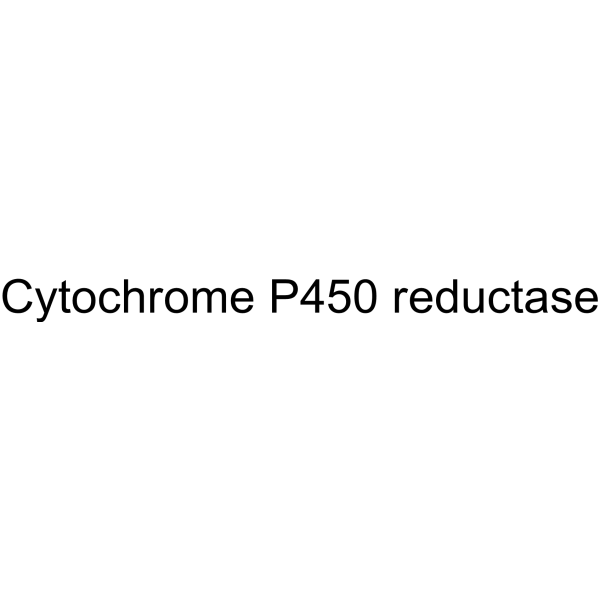cytochrome p450 reductase

cytochrome p450 reductase structure
|
Common Name | cytochrome p450 reductase | ||
|---|---|---|---|---|
| CAS Number | 9039-06-9 | Molecular Weight | N/A | |
| Density | N/A | Boiling Point | N/A | |
| Molecular Formula | N/A | Melting Point | N/A | |
| MSDS | USA | Flash Point | N/A | |
|
The central role of mosquito cytochrome P450 CYP6Zs in insecticide detoxification revealed by functional expression and structural modelling.
Biochem. J. 455(1) , 75-85, (2013) The resistance of mosquitoes to chemical insecticides is threatening vector control programmes worldwide. Cytochrome P450 monooxygenases (CYPs) are known to play a major role in insecticide resistance, allowing resistant insects to metabolize insecticides at ... |
|
|
The role of renal proximal tubule P450 enzymes in chloroform-induced nephrotoxicity: utility of renal specific P450 reductase knockout mouse models.
Toxicol. Appl. Pharmacol. 272(1) , 230-7, (2013) The kidney is a primary target for numerous toxic compounds. Cytochrome P450 enzymes (P450) are responsible for the metabolic activation of various chemical compounds, and in the kidney are predominantly expressed in proximal tubules. The aim of this study wa... |
|
|
Production of human cytochrome P450 2D6 drug metabolites with recombinant microbes--a comparative study.
Biotechnol. J. 7(11) , 1346-58, (2012) The processes of drug development require efficient strategies to produce the respective drug metabolites, which are often difficult to obtain. Biotransformations employing recombinant microorganisms as whole-cell biocatalysts have become an attractive altern... |
|
|
Hydroxylation of non-substituted polycyclic aromatic hydrocarbons by cytochrome P450 BM3 engineered by directed evolution.
J. Inorg. Biochem. 120 , 1-7, (2013) Chrysene and pyrene are known toxic compounds recalcitrant to biodegradation. Here directed evolution allowed us to identify two new mutants of cytochrome P450 BM3 that are able to hydroxylate both compounds. Random mutagenesis has been used to generate libra... |
|
|
Proximal FAD histidine residue influences interflavin electron transfer in cytochrome P450 reductase and methionine synthase reductase
Arch. Biochem. Biophys. 547 , 18-26, (2014) Cytochrome P450 reductase (CPR) and methionine synthase reductase (MSR) transfer reducing equivalents from NADPH to FAD to FMN. In CPR, hydride transfer and interflavin electron transfer are kinetically coupled steps, but in MSR the two catalytic steps are re... |
|
|
Charge-pairing interactions control the conformational setpoint and motions of the FMN domain in neuronal nitric oxide synthase.
Biochem. J. 450(3) , 607-17, (2013) The NOS (nitric oxide synthase; EC 1.14.13.39) enzymes contain a C-terminal flavoprotein domain [NOSred (reductase domain of NOS)] that binds FAD and FMN, and an N-terminal oxygenase domain that binds haem. Evidence suggests that the FMN-binding domain underg... |
|
|
Regulation of intestinal cytochrome P450 expression by hepatic cytochrome P450: possible involvement of fibroblast growth factor 15 and impact on systemic drug exposure.
Mol. Pharmacol. 85(1) , 139-47, (2014) Tissue-specific deletion of the gene for NADPH-cytochrome P450 (P450) reductase (CPR), the essential electron donor to all microsomal P450 enzymes, in either liver or intestine, leads to upregulation of many P450 genes in the tissue with the Cpr deletion. Her... |
|
|
Cytochromeb5and epoxide hydrolase contribute to benzo[a]pyrene-DNA adduct formation catalyzed by cytochrome P450 1A1 under low NADPH:P450 oxidoreductase conditions
Toxicology 318 , 1-12, (2014) In previous studies we had administered benzo[a]pyrene (BaP) to genetically engineered mice (HRN) which do not express NADPH:cytochrome P450 oxidoreductase (POR) in hepatocytes and observed higher DNA adduct levels in livers of these mice than in wild-type mi... |
|
|
Aromatic substitution of the FAD-shielding tryptophan reveals its differential role in regulating electron flux in methionine synthase reductase and cytochrome P450 reductase.
FEBS J. 280(6) , 1460-74, (2013) Methionine synthase reductase (MSR) and cytochrome P450 reductase (CPR) transfer reducing equivalents from NADPH via an FAD and FMN cofactor to a redox partner protein. In both enzymes, hydride transfer from NADPH to FAD requires displacement of a conserved t... |
|
|
Kinetic analysis of cytochrome P450 reductase from Artemisia annua reveals accelerated rates of NADH-dependent flavin reduction.
FEBS J. 280(24) , 6627-42, (2013) Cytochrome P450 reductase from Artemisia annua (aaCPR) is a diflavin enzyme that has been employed for the microbial synthesis of artemisinic acid (a semi-synthetic precursor of the anti-malarial drug, artemisinin) based on its ability to transfer electrons t... |